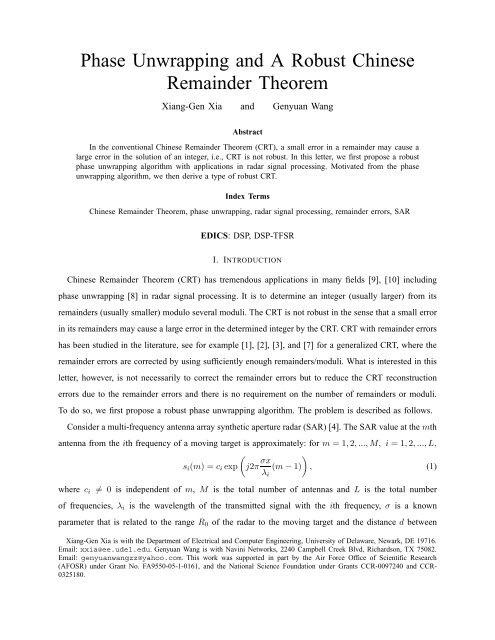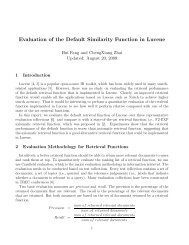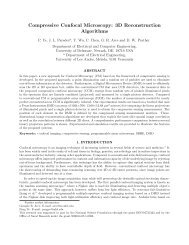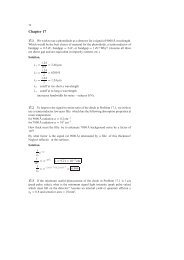Phase Unwrapping and A Robust Chinese Remainder Theorem
Phase Unwrapping and A Robust Chinese Remainder Theorem
Phase Unwrapping and A Robust Chinese Remainder Theorem
You also want an ePaper? Increase the reach of your titles
YUMPU automatically turns print PDFs into web optimized ePapers that Google loves.
<strong>Phase</strong> <strong>Unwrapping</strong> <strong>and</strong> A <strong>Robust</strong> <strong>Chinese</strong><br />
<strong>Remainder</strong> <strong>Theorem</strong><br />
Xiang-Gen Xia <strong>and</strong> Genyuan Wang<br />
Abstract<br />
In the conventional <strong>Chinese</strong> <strong>Remainder</strong> <strong>Theorem</strong> (CRT), a small error in a remainder may cause a<br />
large error in the solution of an integer, i.e., CRT is not robust. In this letter, we first propose a robust<br />
phase unwrapping algorithm with applications in radar signal processing. Motivated from the phase<br />
unwrapping algorithm, we then derive a type of robust CRT.<br />
Index Terms<br />
<strong>Chinese</strong> <strong>Remainder</strong> <strong>Theorem</strong>, phase unwrapping, radar signal processing, remainder errors, SAR<br />
EDICS: DSP, DSP-TFSR<br />
I. INTRODUCTION<br />
<strong>Chinese</strong> <strong>Remainder</strong> <strong>Theorem</strong> (CRT) has tremendous applications in many fields [9], [10] including<br />
phase unwrapping [8] in radar signal processing. It is to determine an integer (usually larger) from its<br />
remainders (usually smaller) modulo several moduli. The CRT is not robust in the sense that a small error<br />
in its remainders may cause a large error in the determined integer by the CRT. CRT with remainder errors<br />
has been studied in the literature, see for example [1], [2], [3], <strong>and</strong> [7] for a generalized CRT, where the<br />
remainder errors are corrected by using sufficiently enough remainders/moduli. What is interested in this<br />
letter, however, is not necessarily to correct the remainder errors but to reduce the CRT reconstruction<br />
errors due to the remainder errors <strong>and</strong> there is no requirement on the number of remainders or moduli.<br />
To do so, we first propose a robust phase unwrapping algorithm. The problem is described as follows.<br />
Consider a multi-frequency antenna array synthetic aperture radar (SAR) [4]. The SAR value at the mth<br />
antenna from the ith frequency of a moving target is approximately: for m = 1,2,...,M, i = 1,2,...,L,<br />
(<br />
s i (m) = c i exp j2π σx )<br />
(m − 1) , (1)<br />
λ i<br />
where c i ≠ 0 is independent of m, M is the total number of antennas <strong>and</strong> L is the total number<br />
of frequencies, λ i is the wavelength of the transmitted signal with the ith frequency, σ is a known<br />
parameter that is related to the range R 0 of the radar to the moving target <strong>and</strong> the distance d between<br />
Xiang-Gen Xia is with the Department of Electrical <strong>and</strong> Computer Engineering, University of Delaware, Newark, DE 19716.<br />
Email: xxia@ee.udel.edu. Genyuan Wang is with Navini Networks, 2240 Campbell Creek Blvd, Richardson, TX 75082.<br />
Email: genyuanwangzz@yahoo.com. This work was supported in part by the Air Force Office of Scientific Research<br />
(AFOSR) under Grant No. FA9550-05-1-0161, <strong>and</strong> the National Science Foundation under Grants CCR-0097240 <strong>and</strong> CCR-<br />
0325180.
1<br />
adjacent antennas, <strong>and</strong> x is an unknown parameter (Doppler shift) to be determined <strong>and</strong> x is related to<br />
the speed <strong>and</strong> location of the moving target. Due to the motion of the target, its Doppler shift x may<br />
cause the target shifted in the SAR image domain. Since x is unknown, the shift amount is unknown <strong>and</strong><br />
therefore, a moving target is usually mislocated in a conventional SAR image. However, when M > 1<br />
<strong>and</strong> L > 1, a reasonable size x can be solved <strong>and</strong> therefore a moving target can be correctly relocated<br />
in the SAR image [4].<br />
From (1), for each i, 1 ≤ i ≤ L, by taking the M-point DFT of s i (m), 1 ≤ m ≤ M, we obtain (only)<br />
integer remainders k i with 0 ≤ k i ≤ M − 1:<br />
f i<br />
∆ =<br />
σx<br />
λ i<br />
= n i + k i<br />
M + ǫ i, (2)<br />
where n i is a non-negative unknown integer <strong>and</strong> ǫ i is an unknown real number with<br />
|ǫ i | ≤ 1<br />
2M . (3)<br />
Clearly, to determine the unknown parameter x, it is sufficient to determine f i . Thus, the problem is to<br />
determine f i from the integer remainders k i . From (2), one can see that ǫ i is the precision error <strong>and</strong> n i<br />
is the folding error. While the precision error ǫ i causes a small error on f i , the folding error n i may<br />
cause a large error on f i . Thus, in order to robustly determine f i , it is necessary to correctly determine<br />
n i . The problem of interest in this letter is how to uniquely determine n i , 1 ≤ i ≤ L, in (2) from k i , λ i ,<br />
1 ≤ i ≤ L, <strong>and</strong> σ <strong>and</strong> M, where the remainders k i , 1 ≤ i ≤ L, may have errors that may occur when<br />
there is an additive noise in signal s i (m) in (1). In the next section, we shall propose a solution for this<br />
problem under some minor conditions on the wavelengths λ i .<br />
The above problem is related to the CRT as follows. Let Γ be a positive number such that Γ i = Γλ i ,<br />
1 ≤ i ≤ L, are all positive integers. If the precision error ǫ i = 0 in (2), then<br />
MΓσx = n i Γ i M + k i Γ i , 1 ≤ i ≤ L. (4)<br />
Let<br />
M i<br />
∆ = Γi M, n ∆ = MΓσx, <strong>and</strong> r i<br />
∆ = ki Γ i , 1 ≤ i ≤ L, (5)<br />
then,<br />
n = n i M i + r i , 0 ≤ r i ≤ M i − 1, 1 ≤ i ≤ L, (6)<br />
which is analogous to the CRT problem of determining n from its remainders r i <strong>and</strong> moduli M i , 1 ≤<br />
i ≤ L.
2<br />
II. A ROBUST SOLUTION<br />
When the remainders k i in (2) have errors that is possible from the M-point DFT detection of the<br />
signal s i (m), what we have is ˜k i :<br />
0 ≤ ˜k i ≤ M − 1 <strong>and</strong> |˜k i − k i | ≤ τ, (7)<br />
where τ < M is the maximal error level in the remainders k i . In this case, (2) becomes<br />
where<br />
f i = σx<br />
λ i<br />
= n i + ˜k i<br />
M + ǫ i, 1 ≤ i ≤ L, (8)<br />
|ǫ i | ≤ 1 + 2τ<br />
2M . (9)<br />
We want to uniquely determine n i in (8) from ˜k i , λ i , <strong>and</strong> M, 1 ≤ i ≤ L. To do so, let Γ be the smallest<br />
positive number such that<br />
Γ i = Γλ i , 1 ≤ i ≤ L, (10)<br />
are all integers <strong>and</strong> Γ i <strong>and</strong> Γ j are co-prime for 1 ≤ i ≠ j ≤ L. Note that this condition may not hold<br />
for all possible positive real numbers λ i , 1 ≤ i ≤ L, but there are enough such λ i in any range. Thus,<br />
in what follows, we always assume that the above condition is satisfied. In fact, in SAR applications, λ i<br />
are the wavelengths that we can design by ourselves <strong>and</strong> therefore flexible to choose.<br />
Without loss of generality, we assume<br />
For 1 ≤ i ≤ L, let<br />
Γ 1 < Γ 2 < · · · < Γ L or equivalently λ 1 < λ 2 < · · · < λ L . (11)<br />
γ i<br />
∆ = Γ1 · · · Γ i−1 Γ i+1 · · · Γ L , (12)<br />
∆ ∆<br />
where γ 1 = Γ2 · · · Γ L <strong>and</strong> γ L = Γ1 · · · Γ L−1 . For each i with 2 ≤ i ≤ L, define<br />
⎫<br />
⎧⎪ ⎨ ∆ S i = (¯n 1 , ¯n i ) = argmin<br />
⎪ ˆn1 = 0,1, · · · ,γ 1 − 1<br />
∣<br />
∣ˆn iΓ i + ˜k i Γ i<br />
M − ˆn 1Γ 1 − ˜k 1 Γ ⎪⎬<br />
1<br />
, (13)<br />
M ∣<br />
⎩<br />
ˆn i = 0,1, · · · ,γ i − 1<br />
⎪⎭<br />
<strong>and</strong> let S i,1 denote the set of all the first components ¯n 1 of the pairs (¯n 1 , ¯n i ) in set S i , i.e.,<br />
S i,1<br />
∆ = {¯n1 : (¯n 1 , ¯n i ) ∈ S i for some ¯n i } (14)<br />
<strong>and</strong> define<br />
We then have the following result.<br />
L⋂<br />
S =<br />
∆ S i,1 . (15)<br />
i=2
3<br />
<strong>and</strong><br />
<strong>Theorem</strong> 1: Assume Γ i <strong>and</strong> Γ j defined in (10) are co-prime for 1 ≤ i ≠ j ≤ L. If<br />
x < 1<br />
σΓ Γ 1Γ 2 · · · Γ L (16)<br />
M > (1 + 2τ)(Γ 1 + Γ L ), (17)<br />
then, set S defined above contains only element n 1 , i.e., S = {n 1 }, <strong>and</strong> (n 1 , ¯n i ) ∈ S i implies ¯n i = n i<br />
for 1 ≤ i ≤ L, where n i , 1 ≤ i ≤ L, are the true solution in (8).<br />
□<br />
Its proof is in Appendix. Note that the case when τ = 0 has been considered in [4] but there is an<br />
error in the result (<strong>Theorem</strong> 1 in [4]) obtained in [4] where the set S i may not necessarily contain only<br />
one pair (n 1 ,n i ) <strong>and</strong> also the proof in [4] has errors. From the above result, we can see that, when<br />
Conditions (16) <strong>and</strong> (17) hold, the folding integers n i in (8) can be uniquely solved <strong>and</strong> the above results<br />
in fact provide an algorithm for the solution of n i from the erroneous remainders ˜k i . When n i in (8) are<br />
correctly solved, the unknown parameter x can be estimated as<br />
(<br />
ˆx = 1 L∑<br />
n i + ˜k<br />
)<br />
i<br />
λ i (18)<br />
σL M<br />
<strong>and</strong> the estimate error can be upper bounded by<br />
i=1<br />
|x − ˆx| ≤ 1 + 2τ<br />
2Mσ<br />
1<br />
L<br />
L∑<br />
λ i . (19)<br />
The above estimate error of x is due to the precision errors ǫ i <strong>and</strong> the remainder errors k i − ˜k i .<br />
i=1<br />
III. A ROBUST CHINESE REMAINDER THEOREM<br />
We now go back to the CRT problem (4)-(6) where the precision errors ǫ i = 0 is because the CRT<br />
concerns only integers <strong>and</strong> there is no fractional errors. From (4) <strong>and</strong> (5), we can see that, for each i<br />
with 1 ≤ i ≤ L, modulo M i = MΓ i <strong>and</strong> remainder r i have a common factor Γ i <strong>and</strong> thus integer n also<br />
has factor Γ i . Since a remainder is known in a priori to have a factor Γ i , its erroneous version ˜r i has a<br />
factor Γ i too, i.e., ˜r i = ˜k i Γ i . Thus,<br />
Assume<br />
Then, for 1 ≤ i ≤ L,<br />
˜r i − r i = ǫ i Γ i . (20)<br />
|ǫ i | ≤ τ, i.e., |˜k i − k i | ≤ τ. (21)<br />
n = n i M i + ˜k i Γ i + ǫ i Γ i . (22)
4<br />
Since n has factors Γ i for 1 ≤ i ≤ L, integer n has to have the form n = n 0 Γ 1 Γ 2 · · · Γ L for some integer<br />
n 0 . Using <strong>Theorem</strong> 1, we immediately have the following corollary.<br />
Corollary 1: Let n = n 0 Γ 1 Γ 2 · · · Γ L for some non-negative integer n 0 . If n 0 < M <strong>and</strong> M > 2τ(Γ 1 +<br />
Γ L ), then n i , 1 ≤ i ≤ L, in (22) can be uniquely determined from ˜k i , Γ i <strong>and</strong> M, 1 ≤ i ≤ L, via<br />
(12)-(15). An estimate of n is<br />
ˆn = 1 L∑<br />
(n i M i +<br />
L<br />
˜k i Γ i ), (23)<br />
i=1<br />
<strong>and</strong> its error is upper bounded by<br />
∣<br />
|ˆn − n| = 1 L∑ ∣∣∣∣ ǫ<br />
L ∣ i Γ i ≤ τ L∑<br />
Γ i . (24)<br />
L<br />
i=1 i=1<br />
□<br />
In the conventional CRT, the moduli have to be pair-wisely co-prime, such as Γ i . In this case, the<br />
reconstruction of n would be expressed as<br />
L∑<br />
ˆn = ˜r i γ i N i , (25)<br />
i=1<br />
where N i is a positive integer such that N i γ i = 1 mod Γ i <strong>and</strong> ˜r i is an erroneous remainder of n modulo<br />
Γ i with error |ǫ i | = |r i − ˜r i | ≤ τ, 1 ≤ i ≤ L. Clearly, the above estimate error due to the erroneous<br />
remainders is at least<br />
ǫ i Γ 1 Γ 2 · · · Γ L−1 ,<br />
which is at least in the order of<br />
τΓ 1 Γ 2 · · · Γ L−1 . (26)<br />
Comparing (26) with the error estimate (24) in Corollary 1, our proposed robust CRT has much less<br />
error than the conventional CRT does. Furthermore, in our case here, the moduli M i = MΓ i , 1 ≤ i ≤ L,<br />
<strong>and</strong> have a common divisor M <strong>and</strong> therefore the conventional CRT reconstruction formula (25) does<br />
not apply. Our study above also provides a reconstruction algorithm of an integer n from its erroneous<br />
remainders when moduli are not pair-wisely co-prime.<br />
IV. SIMULATIONS<br />
We now see some simple simulations. We first consider our proposed robust phase unwrapping<br />
algorithm in Section II. Consider the case when L = 3, λ 1 = 0.4, λ 2 = 0.5, λ 3 = 0.7, <strong>and</strong> σ = 1.<br />
We take Γ = 10. Thus, Γ 1 = 4, Γ 2 = 5, <strong>and</strong> Γ 3 = 7. In this case the maximal range of determinable x<br />
in (16) is 14. In our simulations, the unknown parameter x is uniformly distributed of any real value in<br />
the interval [0,14). We take M = (1 + 2τ)(Γ 1 + Γ L ) + 1 in (17) <strong>and</strong> consider the maximal remainder
5<br />
L=3,λ 1<br />
=0.4,λ 2<br />
=0.5,λ 3<br />
=0.7,σ=1,Γ=10<br />
10 −1 maximal remainder error level τ<br />
estimation error of x<br />
error upper bound<br />
estimation error <strong>and</strong> its upper bound of x<br />
10 −2<br />
10 −3<br />
0 0.5 1 1.5 2 2.5 3 3.5 4 4.5 5<br />
Fig. 1. Estimate error of ˆx in (18) <strong>and</strong> its upper bound in (19) using proposed robust phase unwrapping algorithm. x is a<br />
uniformly distributed real number in [0, 14).<br />
error levels τ = 0,1,2,3,4,5. The error between the estimate ˆx in (18) <strong>and</strong> the true value x is plotted by<br />
the solid line marked with × <strong>and</strong> the error upper bound in (19) is plotted by the solid line marked with<br />
∗ in Fig. 1. Noticing that the mean value of x is 7, one can see that the reconstruction errors of x from<br />
the erroneous remainders ˜k i in (8) are small. Since the parameter x is a general real number, there is a<br />
precision error ǫ i in (2) that is reflected from error curves shown in Fig. 1 when there is no remainder<br />
errors, i.e., when τ = 0. The results shown in Fig. 1 are obtained from 200 trials.<br />
For the robust CRT proposed in Section III, we use the same parameters as in Fig. 1, namely L = 3,<br />
Γ 1 = 4, Γ 2 = 5, Γ 3 = 7, <strong>and</strong> the maximal remainder error levels τ = 0,1,2,3,4,5. We also take<br />
M = (1 + 2τ)(Γ 1 + Γ L ) + 1. Note that M = 2τ(Γ 1 + Γ L ) + 1 is sufficient as stated in Corollary 1<br />
but is not taken to avoid M = 1 when τ = 0, which can be, however, easily verified similarly. For<br />
an integer n = n 0 Γ 1 Γ 2 · · · Γ L , integer n 0 is uniformly taken in the interval [0,M − 1] including 0 <strong>and</strong><br />
M − 1. The estimate error of ˆn in (23) from the true n is plotted by the solid line marked with × in<br />
Fig. 2. The estimate error upper bound in (24) is plotted by the solid line marked with ∗ in Fig. 2. The<br />
errors shown in Fig. 2 can be thought of as absolute errors. The relative errors are shown in Fig. 3 <strong>and</strong><br />
the curves in Fig. 3 are the error curves shown in Fig. 2 divided by the mean values of n, respectively.<br />
The results shown in Fig. 2 <strong>and</strong> Fig. 3 are obtained from 500 trials. One can see that our robust CRT
6<br />
30<br />
estimation error of n<br />
error upper bound<br />
L=3,Γ 1<br />
=4,Γ 2<br />
=5,Γ 3<br />
=7, absolute errors<br />
25<br />
estimation error <strong>and</strong> its upper bound of n<br />
20<br />
15<br />
10<br />
5<br />
0<br />
0 0.5 1 1.5 2 2.5 3 3.5 4 4.5 5<br />
maximal remainder error level τ<br />
Fig. 2.<br />
Absolute estimate error of ˆn in (23) <strong>and</strong> its upper bound in (24) using proposed robust CRT.<br />
provides small relative estimate errors when the remainders are erroneous, which the conventional CRT<br />
can not provide. Compared to the robust phase unwrapping algorithm dealing with real numbers x in<br />
Fig. 1, we are dealing with integers n here <strong>and</strong> thus there is no precision errors, i.e., ǫ i = 0, in (2) <strong>and</strong><br />
the reconstruction (23) is accurate when there is no remainder errors, i.e., τ = 0, which can be verified<br />
from Fig. 2 <strong>and</strong> Fig. 3 where the errors are all zero when τ = 0.<br />
V. CONCLUSION<br />
In this letter, we proposed a robust phase unwrapping algorithm when the remainders have errors.<br />
Motivated from the robust phase unwrapping algorithm, we proposed a type of robust <strong>Chinese</strong> remainder<br />
theorem (CRT) for erroneous remainders. As we have mentioned before, what we want to emphasize<br />
here is that our proposed robust CRT is not trying to correct remainder errors nor precisely reconstruct<br />
an integer as in [1], [2], [3] but to reduce the reconstruction error from the conventional (non-robust)<br />
CRT. Also, what we studied in this letter is only for one integer (one x or one target) <strong>and</strong> different<br />
from the generalized CRT recently studied in [5], [6], [7] where multiple integers (multiple x or multiple<br />
targets) <strong>and</strong> sufficiently many moduli (remainder sets) are involved. Simulation results were provided to<br />
verify the theory. As a remark, this letter not only corrected an error on a result obtained in [4] but also<br />
considered a more general case for erroneous remainders than in [4].
7<br />
L=3,Γ 1<br />
=4,Γ 2<br />
=5,Γ 3<br />
=7, relative errors<br />
3.5 x 10−3 maximal remainder error level τ<br />
3<br />
estimation error <strong>and</strong> its upper bound of n<br />
2.5<br />
2<br />
1.5<br />
1<br />
0.5<br />
estimation error of n divided by the mean of n<br />
error upper bound divided by the mean of n<br />
0<br />
0 0.5 1 1.5 2 2.5 3 3.5 4 4.5 5<br />
Fig. 3.<br />
Relative estimate error of ˆn in (23) <strong>and</strong> its upper bound in (24) using proposed robust CRT.<br />
APPENDIX: PROOF OF THEOREM 1<br />
From Condition (16) on x, it is not hard to see that the true solution n i in (8) falls in the range<br />
0 ≤ n i < γ i for 1 ≤ i ≤ L. Thus, for 2 ≤ i ≤ L <strong>and</strong> any (¯n 1 , ¯n i ) ∈ S i , we have<br />
∣<br />
∣¯n iΓ i + ˜k i Γ i<br />
M − ¯n 1Γ 1 − ˜k ∣<br />
1 Γ ∣∣∣∣<br />
1<br />
M ∣ ≤ n i Γ i + ˜k i Γ i<br />
M − n 1Γ 1 − ˜k 1 Γ 1<br />
M ∣ . (27)<br />
From (8),<br />
Γσx = n i Γ i + ˜k i<br />
M Γ i + ǫ i Γ i , 1 ≤ i ≤ L. (28)<br />
Let µ i<br />
∆ = ¯ni − n i for 1 ≤ i ≤ L. From (28), we replace ˜k i<br />
M Γ i by Γσx − n i Γ i − ǫ i Γ i in both sides of (27)<br />
<strong>and</strong> have<br />
Thus, using (9) <strong>and</strong> (17) we have<br />
|µ i Γ i − µ 1 Γ 1 − (ǫ i Γ i − ǫ 1 Γ 1 )| ≤ |ǫ i Γ i − ǫ 1 Γ 1 |.<br />
|µ i Γ i − µ 1 Γ 1 | ≤ 2|ǫ i Γ i − ǫ 1 Γ 1 | ≤ 1 + 2τ<br />
M (Γ 1 + Γ i ) < 1. (29)<br />
Since µ i , Γ i , µ 1 , <strong>and</strong> Γ 1 are all integers, (29) implies<br />
µ i Γ i = µ 1 Γ 1 , i = 2,3,...,L. (30)
8<br />
Since Γ i <strong>and</strong> Γ 1 are co-prime, (30) implies<br />
µ 1 = m i Γ i <strong>and</strong> µ i = m i Γ 1 ,<br />
i.e., ¯n 1 = n 1 + m i Γ i <strong>and</strong> ¯n i = n i + m i Γ 1 (31)<br />
for some integers m i with |m i | < min(γ i ,γ 1 ). Replacing (31) into (27), we find that<br />
∣ n iΓ i + ˜k i Γ i<br />
M − n 1Γ 1 − ˜k ∣<br />
1 Γ 1<br />
∣∣∣∣¯n<br />
M ∣ = i Γ i + ˜k i Γ i<br />
M − ¯n 1Γ 1 − ˜k 1 Γ 1<br />
M ∣ , (32)<br />
which means (n 1 ,n i ) ∈ S i for i = 2,3,...,L. This proves n 1 ∈ S. We next show S = {n 1 }. Property<br />
(31) also implies<br />
S i = {(n 1 + m i Γ i , n i + m i Γ 1 ) : for some integers m i with |m i | < min(γ i ,γ 1 )}. (33)<br />
If ¯n 1 ∈ S, then ¯n 1 ∈ S i,1 for i = 2,3,...,L, <strong>and</strong> therefore, from the definition of S i,1 in (14) <strong>and</strong> (33),<br />
we have ¯n 1 − n 1 = m i Γ i for some integer m i with |m i | < min(γ i ,γ 1 ) for i = 2,3,...,L. This implies<br />
that ¯n 1 − n 1 divides all Γ i for i = 2,3,...,L <strong>and</strong> therefore from (12), ¯n 1 − n 1 is a multiple of γ 1 . Since<br />
0 ≤ ¯n 1 ,n 1 ≤ γ 1 − 1, we conclude ¯n 1 − n 1 = 0. This proves that S = {n 1 }. In the meantime, ¯n 1 = n 1<br />
implies m i = 0 in (33), i.e., ¯n i = n i for i = 2,3,...,L. Hence, <strong>Theorem</strong> 1 is proved. As a remark,<br />
despite [4] only considers the case when τ = 0, the proof in [4] has errors.<br />
REFERENCES<br />
[1] O. Goldreich, D. Ron, <strong>and</strong> M. Sudan, “<strong>Chinese</strong> remaindering with errors,” IEEE Trans. Information Theory, vol.46,<br />
pp.1330-1338, July 2000.<br />
[2] V. Guruswami, A. Sahai, <strong>and</strong> M. Sudan, “’Soft-decision’ decoding of <strong>Chinese</strong> remainder codes,” Proc. 41st IEEE Symp.<br />
on Found. of Comp. Sci., pp. 159-168, Redondo Beach, California, 2000.<br />
[3] I. E. Shparlinski <strong>and</strong> R. Steinfeld, “Noisy <strong>Chinese</strong> <strong>Remainder</strong>ing in the Lee Norm,” preprint.<br />
[4] G. Wang, X.-G. Xia, V. C. Chen, <strong>and</strong> R. L. Fiedler, “Detection, location, <strong>and</strong> imaging of fast moving targets using<br />
multifrequency antenna array SAR,” IEEE Trans. Aerospace <strong>and</strong> Electronic Systems, vol. 40, pp. 345-355, Jan. 2004.<br />
[5] X.-G. Xia, “Estimation of multiple frequencies in undersampled complex valued waveforms,” IEEE Trans. Signal<br />
Processing, vol. 47, pp. 3417-3419, Dec. 1999.<br />
[6] X.-G. Xia, “An efficient frequency determination algorithm from multiple undersampled waveforms,” IEEE Signal<br />
Processing Lett., vol. 7, pp. 34-37, Feb. 2000.<br />
[7] X.-G. Xia <strong>and</strong> K. Liu, “A generalized <strong>Chinese</strong> remainder theorem for residue sets with errors <strong>and</strong> its application in frequency<br />
determination from multiple sensors with low sampling rates,” IEEE Signal Processing Lett., vol. 12, pp.768-771, Nov.<br />
2005.<br />
[8] W. Xu, E. C. Chang, L. K. Kwoh, H. Lim, <strong>and</strong> W. C. A. Heng, “<strong>Phase</strong> unwrapping of SAR interferogram with multifrequency<br />
or multi-baseline,” Proc. IGASS’94, pp. 730-732, 1994.<br />
[9] J. H. McClellan <strong>and</strong> C. M. Rader, Number Theory in Digital Signal Processing, Prentice-Hall, Englewood Cliffs, N. J.,<br />
1979.<br />
[10] C. Ding, D. Pei, <strong>and</strong> A. Salomaa, <strong>Chinese</strong> <strong>Remainder</strong> <strong>Theorem</strong>: Applications in Computing, Coding, Cryptography, World<br />
Scientific Pub., 1999.











